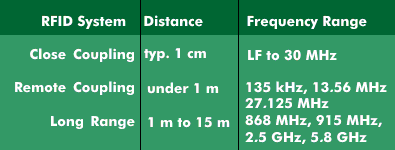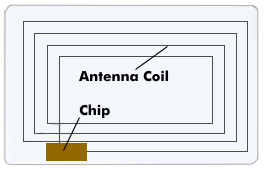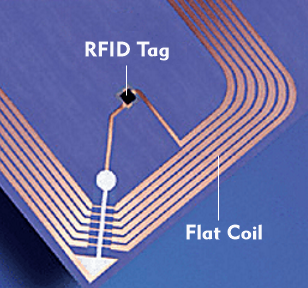radio frequency identification (RFID)
Radio Frequency Identification (RFID) is a wireless method for marking and identifying goods, objects, people and livestock. It is an electronic process that works without contact and transmits the goods data over a certain distance using radio, inductive or resonance coupling. An RFID system consists of the data carrier, which are the RFID tags, an antenna and the RFID reader.
RFID tags - which are transponders with a microprocessor and memory - are used to identify goods, pallets, containers or people and use the Electronic Product Code( EPC). The distance that can be bridged between the tag and the RFID reader depends on the type of RFID tag, the shape and size of the antenna, the RFID frequency and the RFID transmission and can range from a few millimeters to several tens of meters. To prevent eavesdropping on the radio transmission, the distances between the RFID tag and the reader are specified and, according to ISO 14443 and ISO 15693, are about 15 cm for inductive coupling in the long-wave frequency range, about 1.5 m for high frequency and backscatter, and about 15 m in the UHF range.
Active, passive and semi-passive RFID tags
In general, a distinction is made between active, passive and semi-passive tags. Active tags have a rechargeable battery and a transmitter and send the data to the RFID reader.
The range of active tags is much longer than that of passive tags. Passive RFID tags do not have their own power supply; they receive their energy from the reader via radio. Depending on the system and the application, frequencies in the long-wave and short-wave range, but also in the UHF range and in the microwave range are used as RFID frequencies. As a rule , the frequency bands are ISM bands.
When an RFID tag is activated, the reader sends its carrier and data signal to the RFID transponder. This influences the electromagnetic field of the carrier signal by rapidly switching attenuations on and off, which results in a temporary attenuation of the carrier signal. This temporary attenuation of the carrier signal, which represents a load modulation and is detected by the reader, contains the information from the RFID card to the RFID reader. The readout time is in the millisecond range and the bridgeable distance depends on the transmission technology and the antenna. With radio transmission, which operates at frequencies of 128 kHz and higher, distances of up to one meter can be bridged with stationary readers. RFID transmission between tag and reader works with an anti- collision algorithm and has a data transfer rate of 9 kbit/s.
Applications of RFID
Tags are used in merchandise management systems and logistics, as well as in the personal area for access control and electronic ticketing, in animal identification or in motor vehicles as immobilizers, in the collection of tolls and the creation of traffic profiles, and also on smart cards.
RFID supports manufacturers, suppliers, freight forwarders and distributors in logistics, optimization of warehousing and invoicing. In person-to-person applications and on smart cards, RFID technology can be used to create movement patterns and analyze purchasing behavior.



